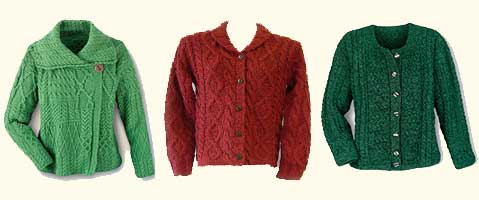 |
Aran
knit sweaters available
from ShopIrish.com |
I was recently posed a question about the famous Irish knit sweaters made in the Aran Islands. In my research I learned something that I didn't know - that there is a myth about the different stitches that are used in these beautiful garments. Almost everywhere you read about Aran knitting there are lists of stitches with the 'traditional' meanings attributed to them; sometimes simple, sometimes very elaborate stories.
The truth is that there are no real authentic meanings to any of the stitches, at least not ones that have any tradition or history behind them. Aran knitting is a relatively recent invention and the stitches were created for their decorative appearance by clever and skillful knitters because they looked nice, not to convey any meaning.
The meanings that are generally attributed to Aran stitches have several origins. The most famous was an article written in 1938 by a German man called Heinz Keiwe, who never visited Aran, never met anyone who knit a sweater and simply made up the meanings. His work, however, was widely accepted as truth by many people, and the sellers of Aran knitwear were not about to contradict such an ingenious marketing idea.
The meanings were then embellished and added to by many later writers who found little literature on the style of knitting. They were relieved to find Keiwe's writings and freely expanded on his meanings, adding new ones that sometimes contradicted Keiwe's originals.
The reason the myth has persisted so long and is so widely believed is because of marketing. Aran knitting was always a commercial enterprise and the attribution of meaning to stitches greatly increased interest in the sweaters. Those producing them realized that and played up to it in promotional literature. Similarly, they now play up the notion of the existence of clan patterns, specific to families, which is completely fictional, but it sells sweaters.
The best work on the history of Aran knitting is a book by Alice Starmore, who separated the facts from fiction in her book, Aran Knitting. For those who are interested, the following are the meanings most often associated with commonly found stitch patterns in Aran knitting.
The most common stitch is the cable, of which there are many variations. These are said to symbolize fishermen's ropes. The blackberry stitch represents nature, and some call it the trinity stitch to give it religious significance, of which there is none. The moss stitch, said to symbolize abundance and growth, is often used as a 'filler' in diamonds. The honeycomb is said to be a lucky stitch, signifying a good catch for the day. Lattice or basket stitches represent the fisherman's basket and, again, an omen of a good catch. The ladder of life and tree of life represent the stages of life. They are sometimes given a religious significance, symbolizing a pilgrim's path to salvation. Plaited or braided stitches are said to represent the interweaving strands of life. Finally, diamonds represent the shape of the fishing net and wealth or success.
If you should happen upon a place selling Aran knit clan sweaters, try to remember that it is nothing more than a marketing campaign to sell more sweaters, and another addition to Mr. Keiwe's article of fiction.
| Aran
Knitting (Hardcover) by Alice Starmore Alice Starmore's definitive explanation of an Irish Aran sweater and its development is surprising and fascinating. Arans are not ancient, and--contrary to popular legend--they were not developed as fishermen's garments. Starmore offers fairly convincing evidence that "true" Aran sweaters were adapted in this century from Scottish fishing ganseys. Starmore, one of the knitting world's living treasures, includes specific cable patterns, patterns for 14 garments (both Aran and Celtic-style), and a clear, sensible guide to designing original Aran sweaters. |
|
 |
Country
Weekend Knits |
 |
Aran Fisherman Sweaters |









